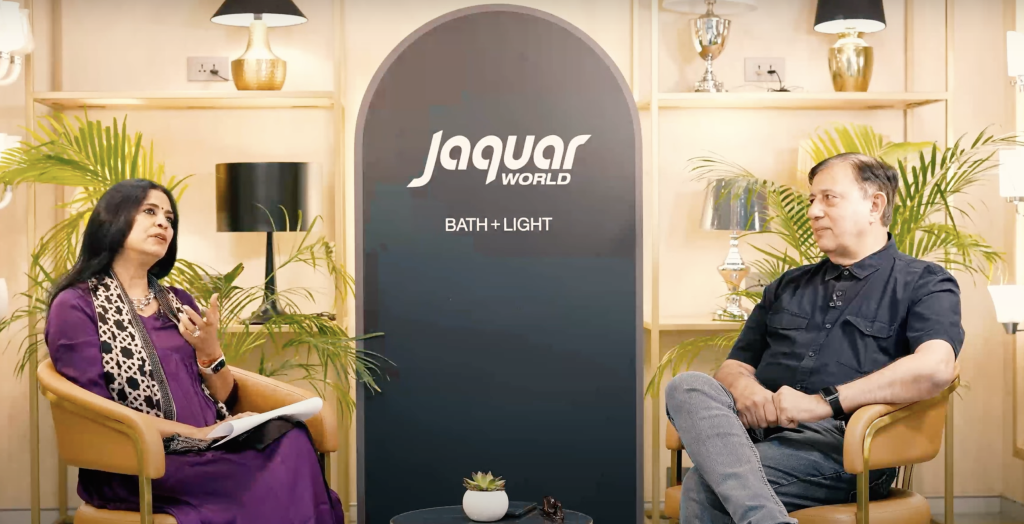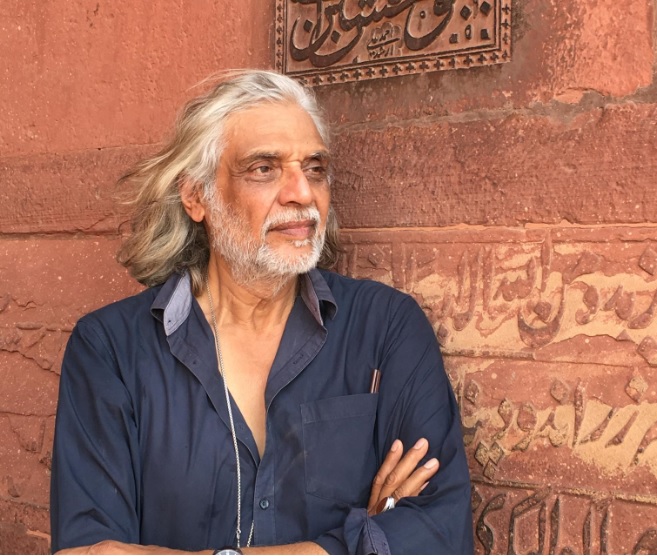Welcome to Samvaad, where art meets conversation, and inspiration knows no bounds. Here we engage in insightful conversations with eminent personalities from the art fraternity. Through Samvaad, Abir Pothi aims to create a platform for thought-provoking discussions, providing readers with an exclusive glimpse into the creative processes, inspirations, and experiences of these creative individuals. From curating groundbreaking exhibitions to pushing the boundaries of artistic expression, our interviews shed light on the diverse perspectives and contributions of these art luminaries. Samvaad is your ticket to connect with the visionaries who breathe life into the art world, offering unique insights and behind-the-scenes glimpses into their fascinating journeys.
In the lively city of Surat, nestled in the western Indian state of Gujarat, a rich history of commerce, and culture weaves its way through bustling streets and modern skylines. In this intriguing dialogue (Samvaad), Ruby Jagrut, founder of Abir India Charitable Trust and an esteemed artist, engages in conversation with Sanjay Punjabi, a prominent figure in Surat’s design and art community. Together, they embark on a journey through Surat’s multifaceted identity, exploring its historical significance, artistic endeavours, and entrepreneurial vigour. From the evolution of Surat’s textile industry to its pivotal role in global finance, Sanjay shares insights on how art, innovation, and commerce intersect in this vibrant metropolis. Through anecdotes, historical perspectives, and reflections on contemporary trends, this dialogue offers a captivating glimpse into the essence of Surat and its enduring legacy on the world stage.
Ruby: The graffiti, which you were delighted to see around the city, ended up in the room of a couple, creating a memorable experience on their wall and transforming the entire space into an immersive experience. When you’re closely associated with different segments of art, such as visual art, literature, and performing arts like theatre, is it tempting for you to naturally incorporate art into your work? Does it become your default setting? How has this multidisciplinary approach helped you grow as a designer over your 33 years of experience?
From day one, you’ve had an aptitude for incorporating art into your designs, but it’s not just visual art—it encompasses photography, literature, cooking, and more. How does this multidisciplinary approach aid your thinking process, and how do you implement it in your projects to continually improve and innovate?
SP: Overall, I believe that no civilisation can exist without art. Throughout centuries, we have lived with art, and in the 19th century, we began to understand how applied art transforms into craft. In the 20th century, design emerged, blending craft with a touch of science. As we look ahead to the 21st century, design has evolved even further. Art remains at its core, accompanied by craft, science, and new technology. Design in the 21st century encompasses art, craft, science, technology, and functionality.
Everywhere we look, we see art. Whether it’s in the elegance of a Louis Vuitton bag or the innovation of a Tesla, art is integrated into every product we encounter. Art is not only unorganized but also organized, evident in products like Louis Vuitton or Tesla. The world is moving towards a future where art and technology are inseparable in every product.
What saddens me is that artists may not always realize their full potential. They need to understand the entrepreneurial aspect of art. By embracing entrepreneurship, artists can elevate their craft to the next level. This entrepreneurial mindset can lead them to new heights and opportunities, creating a fantastic orbit of creativity and innovation.
Ruby: And how do you think that can happen?
SP: Entrepreneurship is fundamentally different from traditional business practices. When we differentiate between a businessman and an entrepreneur, we see that while a businessman focuses on deals, an entrepreneur emphasises teamwork and problem-solving. Similarly, an artist, in their way, also seeks to solve problems by giving language to their emotions through various forms of expression.
Art is not limited to painting or 2D forms; it can manifest as 3D art, photography, literature, and more. Artists evaluate societal happenings and express their emotions in unique ways. By incorporating entrepreneurship into their creative process, artists can enhance their work and create beautiful outcomes. We’re witnessing this trend gaining traction in some parts of the world, where artists are successfully blending creativity with entrepreneurship.
Ruby: Like Anish Kapoor!
SP: Yes, exactly. Anish Kapoor is a prime example of an artist who has embraced entrepreneurship by leveraging technology. He collaborates with companies like G, which provide him with the necessary technology, such as huge 3D printers or advanced materials, to bring his artistic visions to life. This fusion of art and technology, with support from entrepreneurial endeavours, is opening up new horizons in the art world. We are currently witnessing a phase where artists are transitioning into entrepreneurs, with technology catalyzing innovation. As this trend continues to evolve, we can anticipate seeing a plethora of new experiments and creative ventures emerging from the intersection of art, entrepreneurship, and technology, propelling the world into exciting new realms.
Ruby: Yes, artists like Jeff Koons and Subodh Gupta have indeed established themselves as prominent brands solely through their names and artistic expressions. They’ve had a significant impact on cities like Chicago, where landmarks such as the Cloud Gate have become iconic symbols of the city’s identity. Similarly, events like the Kochi Biennale have not only transformed cities but also boosted local economies. I recall a conversation with a rickshaw driver in Kochi, who mentioned that during festivals, they consume mutton daily, highlighting how art can foster community engagement and even influence local traditions.
Regarding Surat, with only around 10% of native Suratis remaining in the city, preserving its unique essence becomes paramount amidst rapid urbanisation. The Surati vibe and virtues are integral to its identity, but as the city evolves, there’s a concern about losing its authentic roots. While the colourful graffiti and vibrant art scenes under the city’s bridges add a new dimension to Surat, one wonders if they align with the Surat we remember from childhood. It’s a question of whether the city has retained its old originality or transitioned into a bustling metropolis.
SP: Absolutely, let’s incorporate the current state of Surat into the discussion. Here’s how we can integrate the provided data:
Surat stands out as the fastest-growing city in the world, as highlighted by a study conducted by Oxford. Notably, the city boasts the lowest crime rate among urban centres. Surat’s economic prowess is evident in its per capita income, which is double the national average in India. Furthermore, Surat has made significant contributions to the global financial landscape, with institutions like the Reserve Bank of India and the Bank of England owing their origins to the city. The word “bank” is given by Surat. Additionally, Surat played a pioneering role in the establishment of insurance practices.
These factors collectively underscore Surat’s remarkable growth trajectory and its historical significance as a hub of innovation and progress.
The area of Nanavat in Surat holds a fascinating history where silver coins were said to be scattered on the streets. Additionally, Surat played a significant role in shaping the identity of Mumbai through historical events such as the marriage of the daughter of the Nawab of Surat. The dowry included the establishment of a port in Mumbai, which contributed to Mumbai’s emergence as a prominent city.
Moreover, Surat holds the distinction of being the birthplace of the world’s first cheque, marking a pivotal moment in financial history. There were points from where indigo was outsourced. One is Kutchh and the other is Bayani near Agra. So to reach Biyani, one had to cross the Chambal, which was notoriously famous for the decoits. So the merchants had to ask the Nagar Seth for a solution. He said, “I’ll give you a letter in my brother’s name so you can present that and you’ll get the money. So you don’t carry money.” When the merchant presented the letter to his brother, he identified the handwriting of his brother and immediately gave him money. When he went back to England, several sessions were happening about how he managed that without money and how the money had been lent. So, English people were very smart, so they identified why they didn’t adopt this system instead of exchanging coins. We write on a piece of paper, and then the check is born. They have given that recognition to the Bank of England because they used to get money from the bank of Surat. This innovation revolutionized the way transactions were conducted and laid the foundation for modern banking systems.
Furthermore, Surat’s influence extended globally, particularly in the textile industry. The indigo dye, sourced from India, was instrumental in dyeing fabrics, including denim. The invention of denim jeans by Levi Strauss in 1873, which celebrated its 150th anniversary in 2023, owes a debt of gratitude to Gujarat, particularly Surat and Ahmedabad, for their role in producing indigo dye. This connection highlights the intertwined relationship between art, commerce, and innovation.
In essence, Surat’s rich history encompasses a myriad of contributions to global trade, finance, and culture, underscoring its significance in shaping the world as we know it today.
Ruby: And you are trying hard to retain that Legacy.
SP: Absolutely, the evolution of art into economic ventures is a testament to its enduring impact and adaptability. While these ventures may not be recognized as traditional forms of art, they undoubtedly originate from artistic endeavours. The colour Tex company in Surat, for instance, may not be perceived as an art entity, yet its production of pigments for denim companies underscores the intersection of art and commerce.
Similarly, the secrecy surrounding certain processes, such as the formulation of Coca-Cola’s recipe, adds to the mystique and allure of these economic ventures rooted in artistry. Although they may not be explicitly labelled as “art,” their origins and essence trace back to artistic innovation and creativity.
Therefore, when art is transformed into economic endeavours, it undergoes a metamorphosis, acquiring new dimensions and functions while retaining its inherent artistic essence. This transformation underscores the dynamic nature of art and its ability to transcend conventional boundaries, leaving a lasting impact on various facets of society, including economics and commerce.
To be continued….
Surat’s Art Renaissance: A Journey from Textiles to Cultural Transformation (Part-1)





